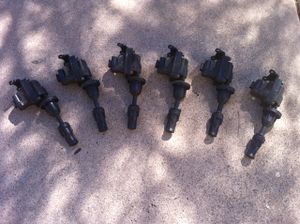Coilpack
Coilpacks are ignition coils for the Z32. In a traditional setup, cars have one ignition coil to amplify battery voltage into a high voltage to create spark. A distributor (usually turned by the camshaft) uses a rotating arm to make temporary connections to different spark plugs (via high-tension wires) at just the right time, causing the spark to fire.
The Z32 uses direct ignition. This means that each cylinder has its own dedicated ignition coil, mounted directly above their respective spark plugs. The ECU controls spark firing and activates power to a coilpack by means of the Power Transistor Unit or PTU (sometimes called an igniter chip). Direct ignition allows the ECU to have tigher, more accurate control over ignition timing.
Z32 Coilpacks
Z32 coilpacks are made up of three main components: a metal bracket to mount them to the intake manifold above their respective spark plugs, the ignition coil body itself, and a short, sealed, high-tension connector that acts as a stiff high-tension wire to allow high voltage to travel from the coil to the spark plug. NA and TT models have different part numbers and some slight physical differences (TT models used a thin spring for the high tension wire with "contact" tips mounted at the end, NAs and later TT models just used thick springs), they are considered functionally the same.
Testing
Coilpacks rarely fail without incident (that is, they won't just up and quit working unless something catastrophic happens to them, such as an electrical short), but the FSM details how to test their function.
The easiest way is to ohm test them. The middle and left (while mounted on the engine) pins should read 0.7Ω. Some have found their coilpacks to indicate as high as 1.2Ω and still function fine--as long as they're all consistent with one another it's likely that they're fully functional. Also keep in mind that there is some inherent resistance in the test leads on multimeters, and that resistance should be subtracted from the coilpack's reading to gain a true reading. For example, if touching your multimeter's leads
together yields 0.4Ω, and your coilpacks are showing 1.1Ω, this would mean they actually show 0.7Ω of resistance.
